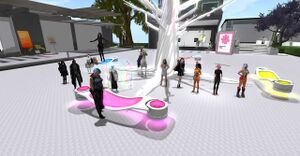Course:FNIS454/Adapting Indigenous Stories: Simulation and Interconnectivity
| FNIS 454 Indigenous New Media | |
|---|---|

| |
| About this Resource | |
| This open access resource is developed by the students of FNIS 454: Indigenous New Media. Via summary and analysis of key article, this wiki explores the theoretical, cultural, socio-political, and gendered dynamics underwriting the histories and futures of Indigenous new media as it develops out of the late 90s and into the present moment. | |
| Index | |
| |
Adapting Indigenous Stories: Simulation and Interconnectivity by Maya Brassard
When considering how to adapt Indigenous stories for digital media, it’s important to engage with the question put forward by Loretta Todd: “What ideology will have agency in cyberspace?” Cyberspace can be defined as a notional communicative environment brought into being through the (interconnected) use of computerized mediums. Over the last 2000 years, a need for cyberspace has been created through the “fear of body, aversion to nature, and desire for transcendence” that shapes Western cultures. That is, cyberspace has (and is) being formed within Western cultures as a means of disembodied escapism. As a result, cyberspace is shaped within contexts defined by neo-cartesian dualisms which foster fragmentation and isolation –a separation of person from body and land. Todd suggests that cyberspace, conceptualized as such, would not have been created by Indigenous Peoples because it negates the interconnectivity that binds all of life. If the framework within which cyberspace has been constructed is fundamentally incompatible with Indigenous world views, how can we remediate story in a good way?
One of the ways that we might begin thinking through this question is by engaging with it in a more specific context –within the context of simulation. Frasca suggests that “to simulate is to model a (source) system through a different system which maintains (for somebody) some of the behaviors of the original system.” As well, simulation can be defined as the collapse of power’s requisite matrix of binaries. These definitions can be a bit confusing at first,but when we think of video games as a form of simulation, things become clearer. As a form of simulation, we can see that video games model the behaviour of objects as they react to specific stimuli in ways that adhere to a certain set of conditions. When these conditions are designed to reflect the interconnectivity of life,video games gain the capacity to produce a merging of embodied and notional experience,transcending the binary of live vs. mediated. With the collapse of this binary, the potential for Indigenous ideologies to obtain agency in cyberspace becomes apparent. By adapting Indigenous stories to platforms that have the capacity collapse the binary between the live and the mediated, that have the capacity to connect users to an embodied experience of land via simulation(e.g., video games, podplays,land-based archives,etc.), Todd suggests that cyberspace can become a place of nourishment, “a place where you do not leave your body and soul, a place where people can locate dreams of humanity and ways to keep the land clean.” That is, through the possibilities offered up by simulation to contest/manipulate the agency/rules of Western ideology in cyberspace, change is made possible –the ‘in alterability’ of settler colonialism is challenged and space is created to embody reciprocal relationships with the land.
